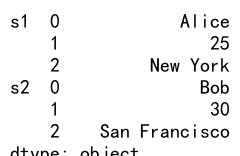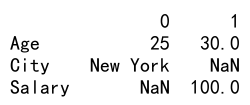Pandas Concat Series to DataFrame
Pandas is a powerful data manipulation library in Python that provides numerous functions and methods to efficiently manipulate large datasets. One of the common operations in data manipulation is concatenating Series objects to DataFrames. This article will explore various ways to concatenate Series to DataFrames using the Pandas library, providing detailed examples and explanations.
Introduction to Pandas Series and DataFrame
Before diving into the specifics of concatenation, it’s important to understand the basic structures of Series and DataFrame in Pandas.
- Series: A Series is a one-dimensional array-like object containing a sequence of values and an associated array of data labels, called its index.
- DataFrame: A DataFrame is a two-dimensional, size-mutable, potentially heterogeneous tabular data structure with labeled axes (rows and columns).
Concatenating a Series to a DataFrame can be useful in many scenarios, such as adding a new column of data, appending rows, or combining multiple datasets.
Example 1: Concatenating a Series as a New Column
To start, let’s see how to add a Series as a new column to an existing DataFrame.
import pandas as pd
# Create a DataFrame
data = {'Name': ['Alice', 'Bob', 'Charlie'], 'Age': [25, 30, 35]}
df = pd.DataFrame(data)
# Create a Series
s = pd.Series(['New York', 'San Francisco', 'Los Angeles'], name='City')
# Concatenate Series as a new column
df['City'] = s
print(df)
Output:

Example 2: Concatenating Multiple Series as Rows
If you have multiple Series and want to concatenate them as rows into a DataFrame, you can use the concat function.
import pandas as pd
# Create multiple Series
s1 = pd.Series(['Alice', 25, 'New York'], index=['Name', 'Age', 'City'])
s2 = pd.Series(['Bob', 30, 'San Francisco'], index=['Name', 'Age', 'City'])
# Concatenate Series as rows
df = pd.concat([s1, s2], axis=1).T
print(df)
Output:

Example 3: Concatenating Series with Different Indices
When concatenating Series with different indices, Pandas aligns them by the index labels.
import pandas as pd
# Create Series with different indices
s1 = pd.Series([25, 'New York'], index=['Age', 'City'], name='Alice')
s2 = pd.Series([30, 'San Francisco'], index=['Age', 'City'], name='Bob')
# Concatenate Series as columns
df = pd.concat([s1, s2], axis=1)
print(df)
Output:

Example 4: Handling Missing Values in Concatenation
When concatenating Series that do not align perfectly, Pandas introduces NaN values for missing data.
import pandas as pd
# Create Series with missing values
s1 = pd.Series([25, 'New York'], index=['Age', 'City'], name='Alice')
s2 = pd.Series([30], index=['Age'], name='Bob')
# Concatenate Series as columns
df = pd.concat([s1, s2], axis=1)
print(df)
Output:

Example 5: Using ignore_index Parameter
The ignore_index parameter can be used to reassign new indices to the resulting DataFrame.
import pandas as pd
# Create multiple Series
s1 = pd.Series(['Alice', 25, 'New York'])
s2 = pd.Series(['Bob', 30, 'San Francisco'])
# Concatenate Series as rows with new index
df = pd.concat([s1, s2], axis=1, ignore_index=True).T
print(df)
Output:

Example 6: Specifying Keys for Hierarchical Indexing
You can specify keys to create a hierarchical index (MultiIndex) when concatenating.
import pandas as pd
# Create multiple Series
s1 = pd.Series(['Alice', 25, 'New York'])
s2 = pd.Series(['Bob', 30, 'San Francisco'])
# Concatenate with keys
df = pd.concat([s1, s2], keys=['s1', 's2'])
print(df)
Output:

Example 7: Concatenating with Different Column Names
When Series do not have the same index names, they can still be concatenated, and the resulting DataFrame will have the union of the index names.
import pandas as pd
# Create Series with different column names
s1 = pd.Series([25, 'New York'], index=['Age', 'City'], name='Alice')
s2 = pd.Series([30, 'San Francisco', 'Male'], index=['Age', 'City', 'Gender'], name='Bob')
# Concatenate Series as columns
df = pd.concat([s1, s2], axis=1)
print(df)
Output:

Example 8: Concatenating with Mixed Types
When concatenating Series containing mixed data types, Pandas preserves the data type for each column.
import pandas as pd
# Create Series with mixed types
s1 = pd.Series([25, 'New York'], index=['Age', 'City'])
s2 = pd.Series([30, 100], index=['Age', 'Salary'])
# Concatenate Series as columns
df = pd.concat([s1, s2], axis=1)
print(df)
Output:

Example 9: Using join Parameter
The join parameter controls how to handle indices on other axes. It can be set to ‘inner’ or ‘outer’.
import pandas as pd
# Create Series with different indices
s1 = pd.Series([25, 'New York'], index=['Age', 'City'])
s2 = pd.Series([30, 'San Francisco', 'Male'], index=['Age', 'City', 'Gender'])
# Concatenate with inner join
df = pd.concat([s1, s2], axis=1, join='inner')
print(df)
Output:

Pandas Concat Series to DataFrame Conclusion
Concatenating Series to DataFrames is a fundamental operation in data manipulation with Pandas. This article has demonstrated various methods to perform this operation, including handling different indices, dealing with missing values, and using parameters like ignore_index and join. By understanding these techniques, you can efficiently combine data from different sources into a single DataFrame for further analysis.
 Pandas Dataframe
Pandas Dataframe